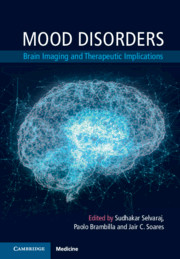Book contents
- Mood Disorders
- Mood Disorders
- Copyright page
- Contents
- Contributors
- Preface
- Section 1 General
- Section 2 Anatomical Studies
- Section 3 Functional and Neurochemical Brain Studies
- Chapter 5 Brain Imaging of Reward Dysfunction in Unipolar and Bipolar Disorders
- Chapter 6 Resting-State Functional Connectivity in Unipolar Depression
- Chapter 7 Functional Connectome in Bipolar Disorder
- Chapter 8 Magnetic Resonance Spectroscopy Investigations of Bioenergy and Mitochondrial Function in Mood Disorders
- Chapter 9 Imaging Glutamatergic and GABAergic Abnormalities in Mood Disorders
- Chapter 10 Neuroimaging Brain Inflammation in Mood Disorders
- Section 4 Novel Approaches in Brain Imaging
- Section 5 Therapeutic Applications of Neuroimaging in Mood Disorders
- Index
- Plate Section (PDF Only)
- References
Chapter 8 - Magnetic Resonance Spectroscopy Investigations of Bioenergy and Mitochondrial Function in Mood Disorders
from Section 3 - Functional and Neurochemical Brain Studies
Published online by Cambridge University Press: 12 January 2021
- Mood Disorders
- Mood Disorders
- Copyright page
- Contents
- Contributors
- Preface
- Section 1 General
- Section 2 Anatomical Studies
- Section 3 Functional and Neurochemical Brain Studies
- Chapter 5 Brain Imaging of Reward Dysfunction in Unipolar and Bipolar Disorders
- Chapter 6 Resting-State Functional Connectivity in Unipolar Depression
- Chapter 7 Functional Connectome in Bipolar Disorder
- Chapter 8 Magnetic Resonance Spectroscopy Investigations of Bioenergy and Mitochondrial Function in Mood Disorders
- Chapter 9 Imaging Glutamatergic and GABAergic Abnormalities in Mood Disorders
- Chapter 10 Neuroimaging Brain Inflammation in Mood Disorders
- Section 4 Novel Approaches in Brain Imaging
- Section 5 Therapeutic Applications of Neuroimaging in Mood Disorders
- Index
- Plate Section (PDF Only)
- References
Summary
Major depressive disorder (MDD) and bipolar disorder (BD) are likely to be etiologically diverse, resulting from the contributions of multiple pathophysiologic processes present in affected individuals to varying degrees. In MDD, there is abundant evidence that alterations in serotonin and other monoamines (1) and glutamatergic signaling (2) are implicated in its pathogenesis, and most available treatments target these pathways.
- Type
- Chapter
- Information
- Mood DisordersBrain Imaging and Therapeutic Implications, pp. 83 - 104Publisher: Cambridge University PressPrint publication year: 2021

